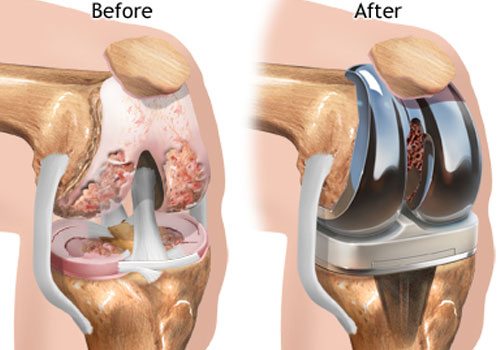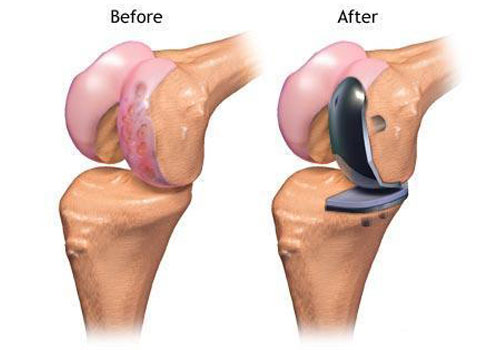
Total Knee Repalacement
It's supplanting or re-emerging of the exhausted smooth covering (Cartilage) with metal coating henceforth re-establishing the usefulness of the joint.
A total knee replacement is a surgical procedure whereby the diseased knee joint is supplanted with counterfeit material. The knee is a pivot joint that gives movement at the point where the thigh meets the lower leg. The thighbone (or femur) adjoins the extensive bone of the lower leg (tibia) at the knee joint.
Amid an all out knee substitution, the finish of the femur bone is expelled and supplanted with a metal shell. The finish of the lower leg bone (tibia) is additionally expelled and supplanted with a directed plastic piece with a metal stem.
Contingent upon the state of the kneecap bit of the knee joint, a plastic "catch" may likewise be included under the kneecap surface. The counterfeit segments of a complete knee substitution are alluded to as the prosthesis.
Strength: Strengthening the muscles that help your knee will decrease weight on your knee joint. Solid muscles help your knee joint assimilate stun.
Flexibility: Stretching the muscles that you reinforce is imperative for reestablishing scope of movement and averting damage. Delicately extending subsequent to reinforcing activities can help decrease muscle soreness and keep your muscles long and adaptable.

COMPUTER NAVIGATION
Computer Navigation is the most recent Infra-red based constant device for performing absolute knee substitution. Route diminishes blunders amid medical procedure by giving ongoing visual data about the precision of the bone cuts, embed situating, tendon adjusting, and last arrangement of the appendage.
Benefits Of Computer Navigation
- No extent of human errors.
- Perfect implant arrangement and adjusting.
- Augments life span of implant.
- Limits blood loss and pulmonary embolism.
- Quicker recovery, quick come back to ordinary exercises
- Can be performed even in patients with past inserts (plate or nail) in bones, serious disfigurements in thigh bone or leg bone, past High tibial osteotomy (HTO), seriously osteoporotic bones, extremely stout/overweight patients.

UNI KNEE REPLACEMENT
During knee substitution medical procedure, harmed bone and cartilage is reemerged with metal and plastic segments. In uni knee replacement (additionally called "Partial" knee replacement) just a bit of the knee is reemerged. This system is a choice to add up to knee trade for patients whose disease is limited to only one area of the knee.
Since a Uni knee replacement is done through a smaller cut, patients more often than not invest less energy in the medical clinic and come back to ordinary exercises sooner than complete knee substitution patients.
Description
In knee osteoarthritis, the cartilage securing the bones of the knee gradually erodes. This can happen all through the knee joint or just in a solitary zone of the knee.
Your knee is divided into three major compartments:
- Medial compartment (the inside part of the knee)
- Lateral compartment (the outside part)
- Patellofemoral compartment (the front of the knee between the kneecap and thighbone)
Advantages
- Quicker recovery
- Less pain after surgery
- Less blood loss
Disadvantages
- Slightly less predictable relief from discomfort
- Potential requirement for more medical procedure. For instance, a complete knee substitution might be vital later on if joint pain creates in the pieces of the knee that have not been supplanted.
PRE OP EVALUATION
- Clinical examination.
- X rays of the knee joint.
- Blood investigations
- CUE.
- Chest x ray.
- ECG.
- 2D echo.
- Physician and cardiologist opinion.
- Anaesthetic check up.
ON THE DAY OF SURGERY
- Medical procedure takes around an hour for single knee substitution.
- Respective knee substitutions are done all the while if necessary.
- Patients are kept in ICU medium-term whenever justified.
KNEE REPLACEMENT PROCEDURE
Readiness of the Bone: The harmed ligament surfaces at the closures of the femur and tibia are expelled alongside a little measure of fundamental issue that remains to be worked out it even.
Situating Inserts: The expelled ligament and bone is supplanted with metal segments that reproduce the outside of the joint. These inserts are solidified or "press-fit" onto the bone.
Restore the patella: The under surface of the patella (knee top) is reemerged with a plastic catch. The vast majority of the occasions restoring the patella isn't required.
Supplement a spacer: A medicinal evaluation plastic spacer is embedded between the metal parts to make a smooth coasting surface.
POSTOPERATIVE PERIOD
Patient is made to stroll with assistance of walker by the physiotherapist.
Knee scope of movement and fortifying activities are educated amid the medical clinic remain.
Hospitalization is for 3-4 days.
It will take a month and a half to get back to normal activites and walk without assistance depending on patient capability.

